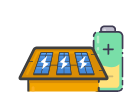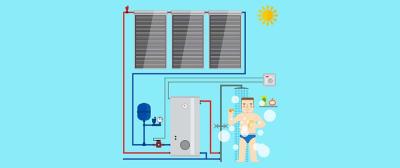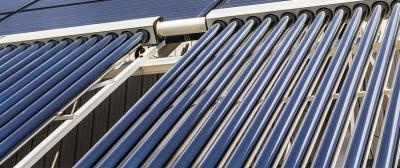Solar PV-T Explained

Image courtesy of YouGen
Solar PV-T panels, or solar photovoltaic-thermal panels, are able to convert solar energy into both electricity and hot water. This means that you don't have to choose between a solar system that either generates electricity or hot water.
What are solar PV-T panels?
Solar PV-T panels are a photovoltaic and thermal hybrid. This means that they're able to convert solar energy into electricity and domestic hot water. So, rather than potentially having to choose between solar panels for electricity or domestic hot water generation, you can have both from a single system.
The technology has been available for a number of years yet remains a niche product.
Difference between solar PV and solar thermal
Solar photovoltaics (PV) convert solar energy into electricity whereas a solar thermal heating system generates heat.
Solar PV panels contain cells that are able to convert solar energy into electricity. At first, this electricity is in direct current (DC), which can't be used in the home. However, a solar inverter then converts it into alternating current (AC) allowing the electrical appliances in the property to be powered by free renewable solar energy.
Solar thermal panels include tubes containing fluid that's heated by the sun. This heated liquid is then circulated down to an immersion heater within a hot water storage cylinder. The immersion heater then warms up the stored water before it's delivered to taps or a wet central heating tank.
Find out more in Solar PV vs Solar Thermal.
How do solar PV-T panels work?
These two solar systems work in very different ways to deliver completely different results – electricity or hot water. Despite their differences, the technologies can be combined into a single hybrid system – solar photovoltaic thermal (PV-T).
The solar PV-T panel include photovoltaic cells that convert solar energy into electricity. There’s also a heat exchanger which transfer the sun’s heat to a liquid which not only heats the water in the cylinder but also cools the solar panel to maximise electricity generation. Solar PV cells begin to lose their efficiency as the temperature goes above 25°C.
Benefits of solar PV-T panels
Combining solar photovoltaic and thermal energy generation into a single hybrid system offers many benefits.
Free renewable electricity and hot water
Thanks to solar PV-T panels, you can have a single solar system that delivers your home with both electricity and hot water. This means that you don't have to choose between one or the other.
Space saving
Depending on the space available on your roof for solar panels, you may have to choose between either a solar PV or thermal system. And if you do have plenty of room available for both systems, you'd have two separate solar systems – one for electricity and another for hot water generation.
Cooling
Solar PV panels are at their most efficient in cooler temperatures. When the outdoor temperature begins to head over 25°C, the output of the system can drop by 0.5% for each degree.
As solar thermal panels are designed to capture this heat, they act as a cooling circuit which increases the efficiency of the renewable electricity generation. According to Millenium electric, the cooling effect of solar PV-T panels can increase efficiencies to 85%.
Incredibly low maintenance
Solar PV and solar thermal panels are very low maintenance and the same goes for solar PV-T systems too.
Are there any downsides to solar PV-T hybrid systems?
One of the biggest benefits of installing solar thermal panels is that you could be eligible to receive payments through the Renewable Heat Incentive (RHI). These are quarterly payments made over a 7 year period to households with a renewable heating system. Unfortunately, solar PV-T systems aren't eligible.
During the winter months, when you'll be needing heating and hot water the most, solar thermal systems won't be able to meet the demand. This means that the thermal generation will need to be supported with another heating system, such as a boiler.
Solar PV-T panel manufacturers
There aren't as many solar PV-T panels available on the market as there are solar PV and solar thermal but you still have several options. Depending on the model, each solar PV-T system will either prioritise electricity or hot water generation.
Some of the leading Solar PV-T models include the PowerTherm, PowerVolt and Solar Angel.
| Solar PV-T Panel | Electric Power | Thermal Power | Product Warranty |
|---|---|---|---|
| PowerTherm | 180 W | 680 W | 10 years |
| PowerVolt | 200 W | 630 W | 10 years |
| Solar Angel | 280 W | 648 W | 10 years |
PowerTherm
Prioritising thermal output, a PowerTherm solar panel will produce around 80% of a conventional flat plate solar thermal panel but also generate electricity.
- Thermal output of 680W
- Electricity output of 180W
- Panels measure 870 x 1640 x 105mm and weigh 34.4kg
- Mono-Crystalline technology
PowerVolt
PowerVolt panels focus on electricity generation while also producing hot water. In its optimal position, PowerTherm panels are capable of producing up to 25% more electricity each year than a conventional solar PV panel thanks to cooled PV cells.
- Electricity output of 200W
- Thermal output of 630W
- Each panel measures 828 x 1601 x 90mm and weighs 24.4kg
- Mono-Crystalline technology
Solar Angel
Solar Angel PV-T panels are arguably the most aesthetically pleasing. The panels are slimline and can be integrated into the roof so they won't distract from the rest of the property. Solar Angel panels focus on electricity generation and can produce up to 20% more electricity than solar PV panels while also contributing to the hot water generation.
Looking to generate your own renewable solar energy?
Generating your own renewable solar energy will make your home more self-sufficient and help to lower your energy bills. And we're here to help you make the best possible start
You can get free quotes for the installation of solar panels from solar installers based in your area. Our network of solar installers are all MCS certified (or equivalent) and up to 3 of them will be in touch to provide a free quote.
By comparing multiple quotes, you'll have the greatest chance of finding the most competitive price for the installation of solar panels. And best of all, there's no-obligation to accept any of the quotes you receive.
Find local, MSC certified Solar Installers
Start your quote
Find local, MSC certified Solar Installers















